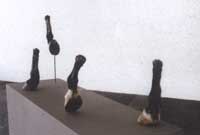The Tamerlane Syndrome:
Art and Conflicts in Central Asia
Palazzo dei Sette, Orvieto , Italy
Opening on the heels of the Central Asian pavilion at the 51-st Venice Biennale, "The Tamerlane Syndrome" was an unexpected entrance to the Silk Road found in the unlikely setting of Orvieto, Italy . Some artists who were in Venice appeared here, but instead of introducing geographical activity from Kazakhstan, Kyrgyzstan or Uzbekistan, works were arranged in a spectrum of tensions, conflicts and revolutions from a region gaining momentous attention in the global spotlight. Throughout the show was a ricocheting call-and-answer of East filtering West, pushing subtle adaptations into autonomous gestures communicating existen tial demands of dislocated spirituality and aggressive solidarity.
Artist Said Atabekov awkwardly poses as a pseudo-shaman, creating objects and situations reminiscent in action to Beuys and in materials to Boetti's stretched camouflages turned totemic fields. Almagul Menlibayeva's videos show shaky, handheld footage of naked women cloaked in oriental fabrics and possessed by ritualistic fits of suppressed sexuality. The videos are split down the middle, doubled over and made into a Rorschachian tactic of perfect simplicity. The lo-fi techniques result in an otherworldly transcendence. There is a definite economy of means prevalent, done not for the sake of itself but achieving an approach that is exact, visceral and effective.
'Barbarism as an aesthetic disposition' seems to be the cringeworthy way to define certain tendencies rooted in this area known for its Huns. Nowhere does this ring truer than in the work of Erbossyn Meldibekov. A brute force of emotion is felt by his video Pastan where Meldibekov sits stonefaced as he is smacked and debased by some unseen aggressor. The scene hints at a dysfunctional domestic encounter but also demonstrates the focused-yet-restrained anger symptomatic of a people submitting to oppressive hand-me-down regimes. A sparkling cross-section of rage and manifest destiny is captured in Gulnara Kasmalieva and Muratbek Djoumaliev's video Revolution (2005). Taken from actual footage last March in Kyrgyzstan , it shows clips of protestors marching onto the grounds of the Winter Palace in Bishkek. Nervous, shifty-eyed authorities background the angry fists and red-faced scowls of a boiling point. The Nutcracker's Sugar Plum Fairy is slowly introduced, synching with the rhythmic actions of this blossoming Tulip Revolution. The soundtrack's crescendo  explodes the crowd into action collapsing the already frail order as flashing shots of fleeing dethronees montaged with insurgent celebrities, palatial looting and the conquering wave of a victor's flag achieve a savage and liberating beauty. This work is punctuated by being paired with Meldibekov's Monument to a Hero, an arrangement of a freshly taxidermied horse's legs positioned in the standard pose found on any bronzed leader's equine monument. This horse and its rider have been knocked swiftly off and all that remains here is the residual and fragmented posture, a socio political metaphor that couldn't be any more current for envisioning an unstable new order.
explodes the crowd into action collapsing the already frail order as flashing shots of fleeing dethronees montaged with insurgent celebrities, palatial looting and the conquering wave of a victor's flag achieve a savage and liberating beauty. This work is punctuated by being paired with Meldibekov's Monument to a Hero, an arrangement of a freshly taxidermied horse's legs positioned in the standard pose found on any bronzed leader's equine monument. This horse and its rider have been knocked swiftly off and all that remains here is the residual and fragmented posture, a socio political metaphor that couldn't be any more current for envisioning an unstable new order.
— Aaron Moulton,
"Flash Art", N245, November-December 2005
The World's Leading Art Magazine